The concept behind the Disney Sports Network was original. Konami and Disney Interactive had built a template for sport videogames featuring the most iconic characters in the world. The developer and publisher managed to deliver the complete vision with Disney Sports Soccer but failed to follow up with any other title in the series. This was no more evident with their basketball and skateboarding games. In order to understand how and even why the games failed we have to look at the publisher and see their history with sport titles. Konami had a very specific track record when it came to sport titles. This experience was reflected in Disney Sports Soccer. At one time Konami had two teams developing professional football (soccer) games, the Winning Eleven and Pro Evolution Soccer series. They had been working with the international sport for over 15 years. The PES franchise had been very successful and that experience was evident in Disney Sports Soccer.
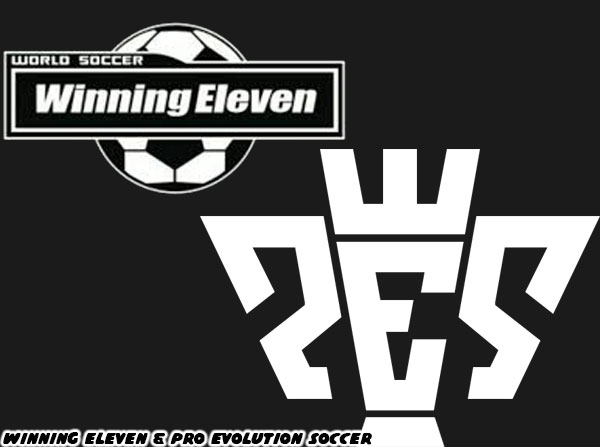
The studio based out of Osaka had only limited experience with sports and activities more popular in the west. A great basketball game had eluded Japanese developers for some time. The most memorable basketball game Konami produced was Double Dribble. An arcade title from 1986 that was ported to the Nintendo Entertainment System a year later. Their experience with basketball was spotty at best. Disney Sports Basketball was not a sim or 5-on-5 game but rather a faster paced 3-on-3 arcade experience. The game borrowed the elements that I spoke about in the previous blog, with regards to the teams, stadiums, uniforms and colors. Plays were quick and dunks were presented with over-the-top animations. It could be considered an attempt at making an NBA Jam-style game with Disney characters. Unfortunately the stiff control, poor balance, questionable collision detection and canned animations detracted from the title.

Control-wise the game was also the simplest to play, or at the very least fastest to master. On the easy setting players could dominate the competition with a couple of buttons. Passing, shooting and defending were completed with two buttons. On the harder settings scoring became frustratingly difficult as opponents stole or blocked the ball with efficiency and had a higher percentage of shots and dunks go in. Advanced players could actually enjoy the depth provided by the game targeted at youngsters. While it offered the frenetic scoring and over-the-top dunks of NBA Jam it also had a basic crossover move like NBA STREET as well as the ability to change formations and back down opponents like NBA Live. Players could switch relatively quickly between the tactics to find which worked for their particular character and style of play. This mix of arcade and sim elements meant that players could enjoy the gameplay in more than one format. Two buttons worked against opponents on the easiest setting but players had to master the four regular button and two shoulder button commands if they wanted to survive on the harder modes.


As an aside I failed to mention that Pete was also the pivotal character in the DSN Soccer game. At the end of the Challenge Cup mode the player would have to take on Pete's All Stars, rather than the Steamrollers. This team had its own Stadium, playing in Vista Arena in outer space, which was the setting meant for Goofy's SpaceNuts team. Pete's All Stars also had their own uniforms, black and gray striped in a stark contrast to the bright orange of the Steamrollers. The ref Jose Carioca and the linesmen Huey, Dewey and Louie had bright yellow alternate uniforms instead of their regular black uniforms. The All Stars were composed of all the bad guy characters in the title, Pete and his hogs, Mortimer and his dogs and the Big Bad Wolf and his wolf teammates. The three mascot characters all had access to their magic abilities and trying to beat them was next-to-impossible as the rivals trounced players with an assortment of cheap shots and magic attacks. The difficulty curve with the magic shoes enabled was maddening, possibly surpassing the difficulty of Ninja Gaiden in its hardest mode. The only realistic way to defeat the team was to play through a season without any magic allowed. Additionally, if players managed to unlock all 40 magic shoes in the game they were rewarded with the Tiny Rockets, a team made up of the ref and linsemen from the game and the four all had access to magical shoes, making them the most powerful team in the game. Both Pete's All Stars and the Tiny Rockets could only be selected in the Exhibition Mode and not the Challenge or Dream Cup modes.

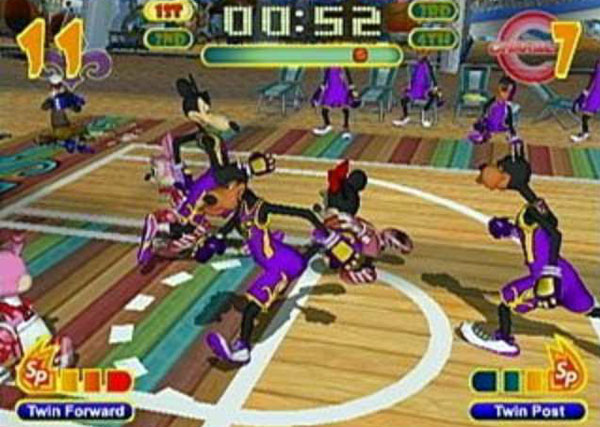
From an animation standpoint the team at Konami had mastered the difficulties of creating realistic movement when the characters themselves had unrealistic proportions. Think about the challenges of having cartoon characters perform actions in three dimensions. How difficult would it be to have the short Huey, Louie or Dewey convincingly dribble a basketball almost as big as they were, or have the flat-footed Donald dribble a soccer ball across a field with his webbed feet? What about contests where height and size were supposed to matter? In the basketball title the shorter Minnie Mouse was supposed to be on par with the tall and lanky Goofy. There was also the challenge of having any character go up against the massive Steamrollers lineup and survive. The team at Konami in Osaka answered the challenges while respecting the legacy of the characters. The dribbling of the Tiny Rockets was fast and frenetic, as the ball did not have long to travel to the ground. Donald would lean forward and run full bore with a waddle in a wide-stance while keeping the ball close on dribbles, on free kicks he would turn his back to the person kicking the ball look then over his shoulder and shake his tail as a challenge / target. Minnie had a higher-than-average three point shot ability so she did not have to get close to the rim and attempt a dunk against taller opponents, this did not mean she couldn't dunk though. While the mascots maintained a happy facade in the other titles the grim determination was most evident and appropriate on those faces in the soccer title.


The other saving grace, like those of most of the DSN games were the character designs and even concept art provided by the Disney artists. These rarely seen pieces showed the mood and atmosphere that the title was trying to present. These pieces gave the characters dimension far beyond a typical mascot sketch or any other Disney illustration of that time. Unfortunately most of the games failed to reproduce that sense of vulnerability, competitiveness or passion. They instead reduced the characters to the glassy-eyed, grinning mascots most people associate with the modern Disney characters.
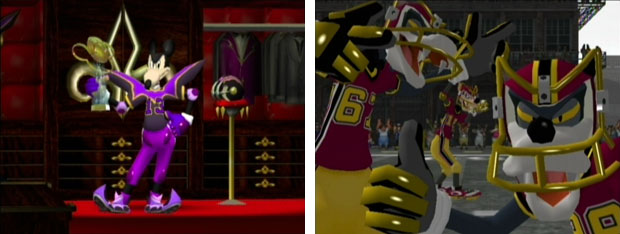
Disney Sports Soccer came close to achieving gameplay that was on par with the opening cinema. DSN Skateboarding did not come close. The only thing that the skateboarding game had in common with the opening cinema were the locations. All of the levels and some of the features shown in the cinema made it into the game. The flow of the levels (the lines of the skatepark construction) was decent but the control of the characters and the multiplayer aspects were poor to nonexistent. I forced myself to play through the game through completion, again and again, to try and squeeze every ounce of detail that I could from the game.
Konami had only produced a few other skateboarding games before DSN Skateboarding. The two previous, ESPN X-Games Skateboarding released in 2001 and Evolution Skateboarding released a year later were met with mixed reviews. There were few changes made to the original X-Games Skateboarding engine to make it the backbone of both DSN and Evolution Skateboarding. That engine was one based on the Metal Gear Solid 2 engine that also happened to power the Winning Eleven game. Konami had built a powerful gaming engine, potentially spending millions in the process, that could be ported for different genres and even consoles. The thing that all the titles using the engine had in common were with the graphics. The engine was able to present fantastic 3D models with great lighting, textures and effects. It was able to recreate the physical traits of an actual skateboarder like Danny Way, a cartoon character like Donald Duck or even a Konami legend like Solid Snake while staying true to the source material and art direction.
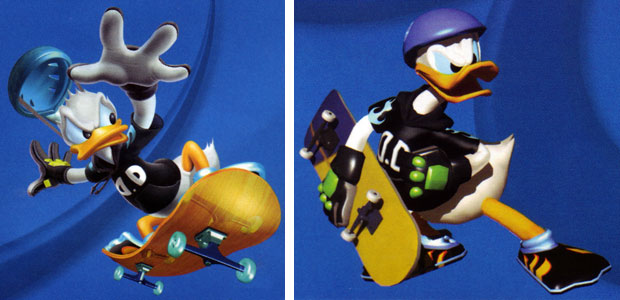
For the skateboarding games the character models were all very detailed and appeared fantastic even when compared to the best work coming out of Neversoft, then the developers of the Tony Hawk games.
Where all three Konami skateboarding games failed was in the control department. Despite being detailed models, the characters moved stiffly and the control was even poorer. Turns were slow and clumsy, acceleration was a challenge and activating tricks was difficult even with practice. An activity like skateboarding demanded a certain sense of fluidity, range of motion and speed. Videogames rarely captured the sense of movement and freedom to explore the environment in ways that actual skateboarders could. Skateboarding games challenged developers differently than any other genre. The act of skateboarding was tricky yet had to be be made accessible and fun for gamers. Few outside of Neversoft managed to get that issue solved.

Konami tried to supplement the lack of control experience by changing the formula of a serious skate sim. They added themed environments and even "set pieces" to their titles. Both X-Games and DSN Skateboarding added exploration and even fantasy elements to their level design while Evolution Skateboarding introduced the concept of "boss battles" such as fighting a giant spider, stopping a runaway truck, planting bombs on an oil platform or battling a maniac in a tank. The oil rig and explosives, along with character models of Solid Snake and Raiden featured in Evolution Skateboarding were brought over from MGS2. Simon Belmont of Castlevania fame, Frogger and a few other random characters from Konami's library were put in Evo Skateboarding as well. Unfortunately all of these elements were undone by impossibly stiff controls.
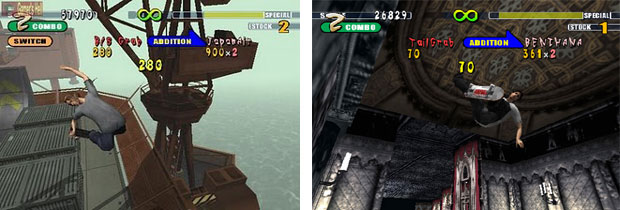
I am a die-hard skateboarding game aficionado. I've played almost every skateboarding game made for consoles, handhelds, computer systems and the arcade. I still own many skateboarding games long forgotten by players. Unfortunately I also pride myself as being a glutton for gaming punishment. I grind through many games not worth the trouble just to see if I can find any redeeming factors in the title, or to try and understand where the designers were trying to go with the game. I played through Disney Skateboarding with every character, in every mode and searched through all the levels for secrets and unlockable content. Most gamers, even die-hard Disney fans refused to play for longer than a few minutes after feeling how stiff and unresponsive the controls were. The learning curve was also brutal as players not only had to learn how to do tricks but also had to complete certain objectives under a time limit. Even with a map to guide players to objectives, reaching some of the locations required thorough knowledge of the level, patience and sharp timing. How a young gamer could accomplish this was beyond me. There were also features touted in the manual and highlighted in the game like alternate costumes and several hidden boards that could never be unlocked. A handful of hidden boards never showed up in any level which frustrated a completion freak like me. The unintuitive checkpoint race, the unfinished training mode and brutally hard contest mode made for for an unforgivable experience. Unlocking everything in the game took almost two dozen hours to accomplish and I am sad for both Disney and Konami because I had to fight the game and controller every minute of the way.

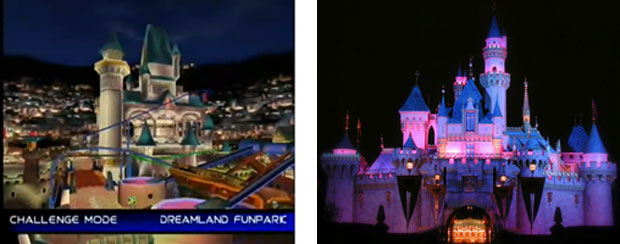
This game was also one of the rare titles to incorporate grind-able roller coaster tracks in the level design. Jet Set Radio Future, Tony Hawk's Pro Skateboarding 4 and Disney Skateboarding were all released in 2002 and they all had al least one roller coaster track in a level. The Disney and JSRF games allowed for characters to grind upside down, corkscrew and loop on the track. It was a fun dynamic that completely changed the way players approached levels and took gameplay and level design to new heights. The level Dreamland Funpark was inspired greatly by the Magic Kingdom, with an amusement park-meets-fantasy castle setting the stage. It was even framed with fireworks shooting off in the distance, a very nostalgic touch. Konami answered one of the challenges presented in the opening cinema by allowing the characters to do the impossible while skateboarding. It made for one memorable element in a game which was otherwise easily forgettable. Unfortunately it also highlighted one of game design choices that would handicap the vision behind the series.

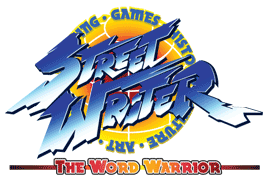
No comments:
Post a Comment